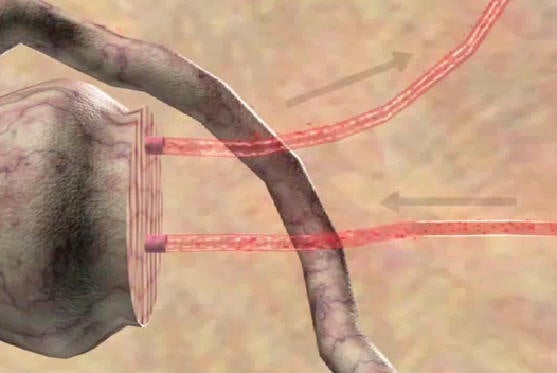
KINGSTON, R.I. – July 11, 2006 – Roberta S. King was frustrated three years ago when she tried to explain to her University of Rhode Island pharmacy students how diuretic drugs work at a cellular level in the body.
“You can talk about how the drugs work and you can use still diagrams, but those methods are not very effective for explaining a lengthy, moving process,” said the assistant professor of pharmacy and Narragansett resident. “None of the textbooks explain this in a way that makes the sequence of movement understandable.”
So King turned to the advanced visual technologies newly available at the University through complimentary programs funded by the Champlin Foundations to create an animated movie. The grants were used to create a 3D animation facility in the College of Pharmacy and a Digital Production Resource Center with the Information Technology Services Department at the Chafee Social Science Center.
King began showing a short form of the movie in class in spring 2005. It depicts how diuretics that are used to treat heart failure and high blood pressure modify sodium ion transport in the kidney.
The movie starts by showing the viewer the kidney and then zooms inside the kidney to show one nephron. There are about 1 million nephrons in each kidney, the tiny units where filtering occurs to remove waste and water from the blood. According to King, “The nephron is very much like a leaky hose, but the body carefully controls exactly what leaks and where. The diuretic drugs modify this control. The footage then moves into the cells forming the wall of the nephron where transport is controlled, showing where and how the diuretic drugs act.”
The movie, which is posted on King’s website, has been viewed by people in Washington, New York, Istanbul, Ontario, and India. “Even though we haven’t marketed this, people are finding this by going on Google, so it must be serving an important need,” King said.
 Click the image to visit the movie website. https://www.uri.edu/pharmacy/animation/steveKingkidney.htm.
Click the image to visit the movie website. https://www.uri.edu/pharmacy/animation/steveKingkidney.htm.
From the beginning, she had the help of Steven Barbera, a communications studies student from Wakefield, and a student technology assistant, which is supported by URI’s Information Technology Services Department. Barbera used the Digital Production Center to develop portions of the movie. “With my guidance, Steven was really the producer of the movie,” King said. “In a process that is similar to developing a cartoon story board, we started with a series of still hand drawings that I provided to Steven.”
King and Barbera started the diuretic animation in October 2004 and completed the 45-second version by January 2005 using the 3D animation facility in the College of Pharmacy. “The movie was so effective that I wanted to show more of the process, and so over the next year, Steven tripled the length of the animation and then used the center in Chafee to make it into a professional quality movie, complete with narration provided by Steven. The final 9-minute movie was used this past spring.
“The narration is very important because it explains exactly what is happening at each moment,” King said. “Steven did a great job taking my story board and still drawings and turning them into detailed but clear sequences to show what the process would be like in the body.”
Roy Bergstrom, supervisor of the Student Technology Assistants Program and the Digital Production Resource Center, said the center can produce movies that show dynamic processes as they happen. “The movie we made for Roberta allows the eye to follow the process. Now students can connect a real image with abstract thinking. Without this technology, how can students see something at a molecular level?”
One of the oldest philanthropic organizations in Rhode Island, The Champlin Foundations generosity towards URI spans more than three decades. In 1970, The Foundations made their first donation to the University in the form of an annual scholarship grant for the College of Pharmacy. Their next gift was in 1982 and since then The Foundations have awarded grants to URI every year, consistently placing the University as one of the top five organizations to receive funding for some of the latest technology, materials, and other research and teaching tools. See URI’s Corporate and Foundation Relations.
Media Contact: Dave Lavallee, 401-874-5862

